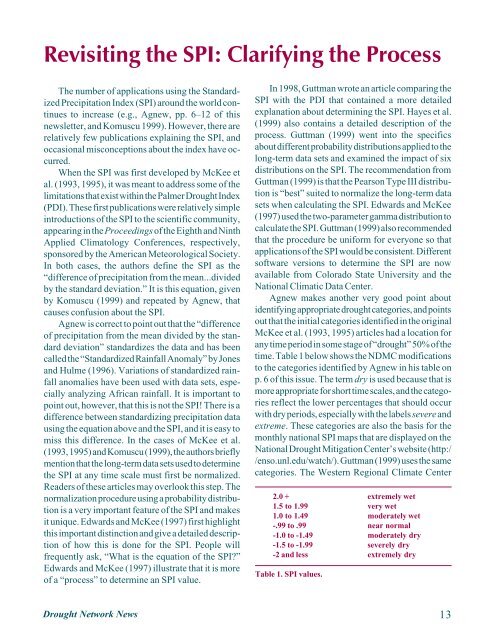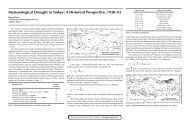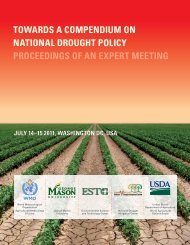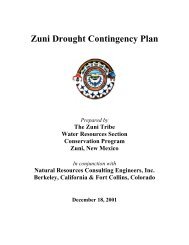Did you know . . . - the National Drought Mitigation Center
Did you know . . . - the National Drought Mitigation Center
Did you know . . . - the National Drought Mitigation Center
You also want an ePaper? Increase the reach of your titles
YUMPU automatically turns print PDFs into web optimized ePapers that Google loves.
Revisiting <strong>the</strong> SPI: Clarifying <strong>the</strong> ProcessThe number of applications using <strong>the</strong> StandardizedPrecipitation Index (SPI) around <strong>the</strong> world continuesto increase (e.g., Agnew, pp. 6–12 of thisnewsletter, and Komuscu 1999). However, <strong>the</strong>re arerelatively few publications explaining <strong>the</strong> SPI, andoccasional misconceptions about <strong>the</strong> index have occurred.When <strong>the</strong> SPI was first developed by McKee etal. (1993, 1995), it was meant to address some of <strong>the</strong>limitations that exist within <strong>the</strong> Palmer <strong>Drought</strong> Index(PDI). These first publications were relatively simpleintroductions of <strong>the</strong> SPI to <strong>the</strong> scientific community,appearing in <strong>the</strong> Proceedings of <strong>the</strong> Eighth and NinthApplied Climatology Conferences, respectively,sponsored by <strong>the</strong> American Meteorological Society.In both cases, <strong>the</strong> authors define <strong>the</strong> SPI as <strong>the</strong>“difference of precipitation from <strong>the</strong> mean...dividedby <strong>the</strong> standard deviation.” It is this equation, givenby Komuscu (1999) and repeated by Agnew, thatcauses confusion about <strong>the</strong> SPI.Agnew is correct to point out that <strong>the</strong> “differenceof precipitation from <strong>the</strong> mean divided by <strong>the</strong> standarddeviation” standardizes <strong>the</strong> data and has beencalled <strong>the</strong> “Standardized Rainfall Anomaly” by Jonesand Hulme (1996). Variations of standardized rainfallanomalies have been used with data sets, especiallyanalyzing African rainfall. It is important topoint out, however, that this is not <strong>the</strong> SPI! There is adifference between standardizing precipitation datausing <strong>the</strong> equation above and <strong>the</strong> SPI, and it is easy tomiss this difference. In <strong>the</strong> cases of McKee et al.(1993, 1995) and Komuscu (1999), <strong>the</strong> authors brieflymention that <strong>the</strong> long-term data sets used to determine<strong>the</strong> SPI at any time scale must first be normalized.Readers of <strong>the</strong>se articles may overlook this step. Thenormalization procedure using a probability distributionis a very important feature of <strong>the</strong> SPI and makesit unique. Edwards and McKee (1997) first highlightthis important distinction and give a detailed descriptionof how this is done for <strong>the</strong> SPI. People willfrequently ask, “What is <strong>the</strong> equation of <strong>the</strong> SPI?”Edwards and McKee (1997) illustrate that it is moreof a “process” to determine an SPI value.In 1998, Guttman wrote an article comparing <strong>the</strong>SPI with <strong>the</strong> PDI that contained a more detailedexplanation about determining <strong>the</strong> SPI. Hayes et al.(1999) also contains a detailed description of <strong>the</strong>process. Guttman (1999) went into <strong>the</strong> specificsabout different probability distributions applied to <strong>the</strong>long-term data sets and examined <strong>the</strong> impact of sixdistributions on <strong>the</strong> SPI. The recommendation fromGuttman (1999) is that <strong>the</strong> Pearson Type III distributionis “best” suited to normalize <strong>the</strong> long-term datasets when calculating <strong>the</strong> SPI. Edwards and McKee(1997) used <strong>the</strong> two-parameter gamma distribution tocalculate <strong>the</strong> SPI. Guttman (1999) also recommendedthat <strong>the</strong> procedure be uniform for everyone so thatapplications of <strong>the</strong> SPI would be consistent. Differentsoftware versions to determine <strong>the</strong> SPI are nowavailable from Colorado State University and <strong>the</strong><strong>National</strong> Climatic Data <strong>Center</strong>.Agnew makes ano<strong>the</strong>r very good point aboutidentifying appropriate drought categories, and pointsout that <strong>the</strong> initial categories identified in <strong>the</strong> originalMcKee et al. (1993, 1995) articles had a location forany time period in some stage of “drought” 50% of <strong>the</strong>time. Table 1 below shows <strong>the</strong> NDMC modificationsto <strong>the</strong> categories identified by Agnew in his table onp. 6 of this issue. The term dry is used because that ismore appropriate for short time scales, and <strong>the</strong> categoriesreflect <strong>the</strong> lower percentages that should occurwith dry periods, especially with <strong>the</strong> labels severe andextreme. These categories are also <strong>the</strong> basis for <strong>the</strong>monthly national SPI maps that are displayed on <strong>the</strong><strong>National</strong> <strong>Drought</strong> <strong>Mitigation</strong> <strong>Center</strong>’s website (http://enso.unl.edu/watch/). Guttman (1999) uses <strong>the</strong> samecategories. The Western Regional Climate <strong>Center</strong>2.0 + extremely wet1.5 to 1.99 very wet1.0 to 1.49 moderately wet-.99 to .99 near normal-1.0 to -1.49 moderately dry-1.5 to -1.99 severely dry-2 and less extremely dryTable 1. SPI values.<strong>Drought</strong> Network News13








